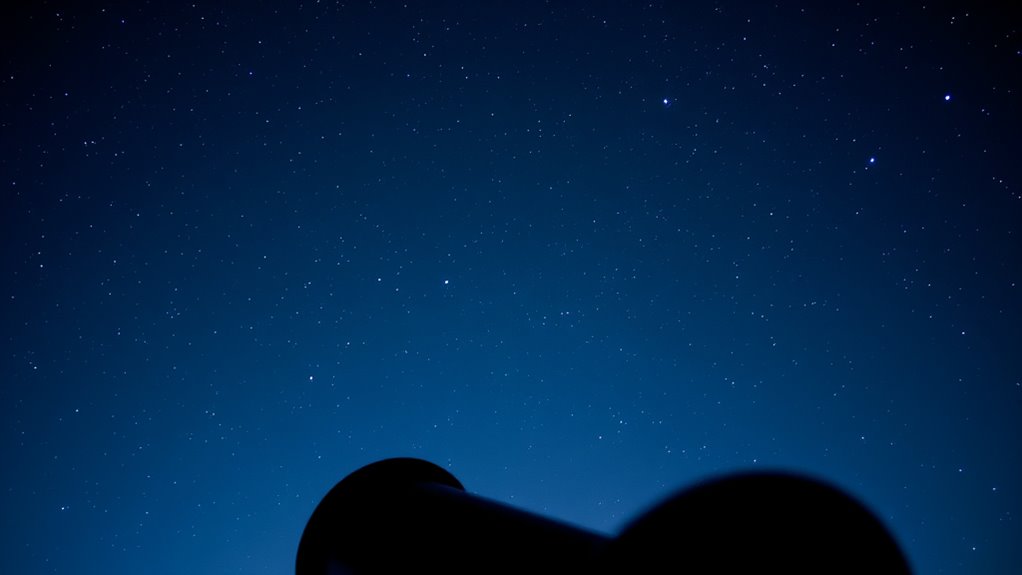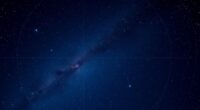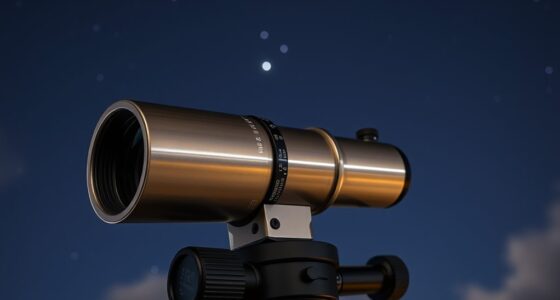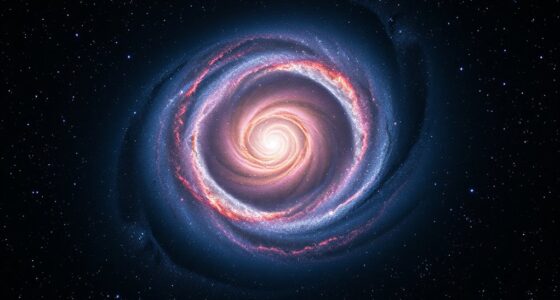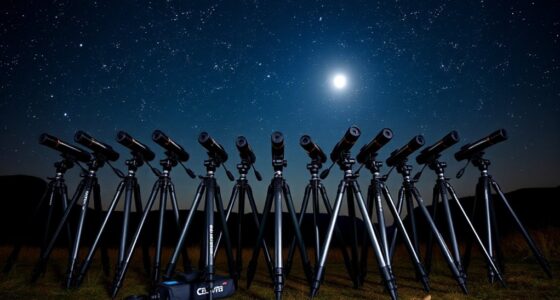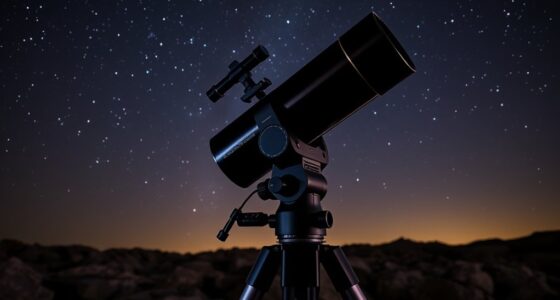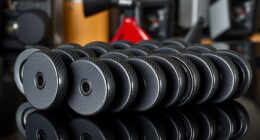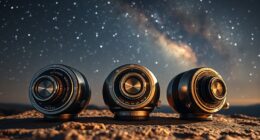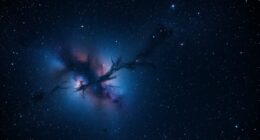Looking to improve your stargazing in 2025, I recommend the best Celestron duo-band filters that enhance contrast and reduce light pollution. Options like the Celestron Origin Nebula Filter and SVBONY’s dual-band nebula filter focus on specific emission lines, revealing nebulae with greater clarity. The Celestron Narrowband Oxygen III filter and versatile kit bundles offer even more detail and convenience. Keep exploring, and you’ll discover the perfect filters to make your sky observations sharper and more vivid.
Key Takeaways
- Celestron Duo Band Filters enhance contrast by isolating specific emission lines, improving nebula and galaxy details during stargazing.
- These filters block light pollution and moon-glow, providing clearer views in urban or light-polluted areas.
- Compatibility with various Celestron telescopes and accessories ensures versatile use for different observational setups.
- High-quality coatings and durable glass materials ensure optimal light transmission and longevity for consistent performance.
- Choosing the right Duo Band filter depends on target objects and observing conditions for optimal clarity in 2025.
Celestron Origin Nebula Filter for Astroimaging

If you’re serious about astrophotography with your Celestron 6-inch RASA, the Origin Nebula Filter is a must-have. It blocks light pollution, boosts contrast, and darkens the sky background, making nebulae pop in your images. This filter transmits essential emission lines—Hydrogen-Alpha, Hydrogen-Beta, and Oxygen III—so nebulae stand out vividly against dark skies. Designed specifically for the RASA, it installs effortlessly by removing the optical window from the filter drawer. With this filter, you’ll capture clearer, more detailed images, especially in urban or suburban environments where light pollution is a challenge.
Best For: Amateur and professional astrophotographers using Celestron’s 6-inch RASA seeking to improve nebula imaging in light-polluted environments.
Pros:
- Effectively blocks light pollution and sky glow for clearer images
- Transmits key emission lines (Hydrogen-Alpha, Hydrogen-Beta, Oxygen III) for vivid nebulae detail
- Easy to install by removing the optical window without additional adapters
Cons:
- Designed specifically for Celestron’s 6-inch RASA, limiting compatibility with other telescopes
- May require careful handling during installation to avoid optical misalignment
- Primarily beneficial for astrophotography; less useful for visual observing
67mm X2 CPL Circular Polarizing Filter for Camera Lenses
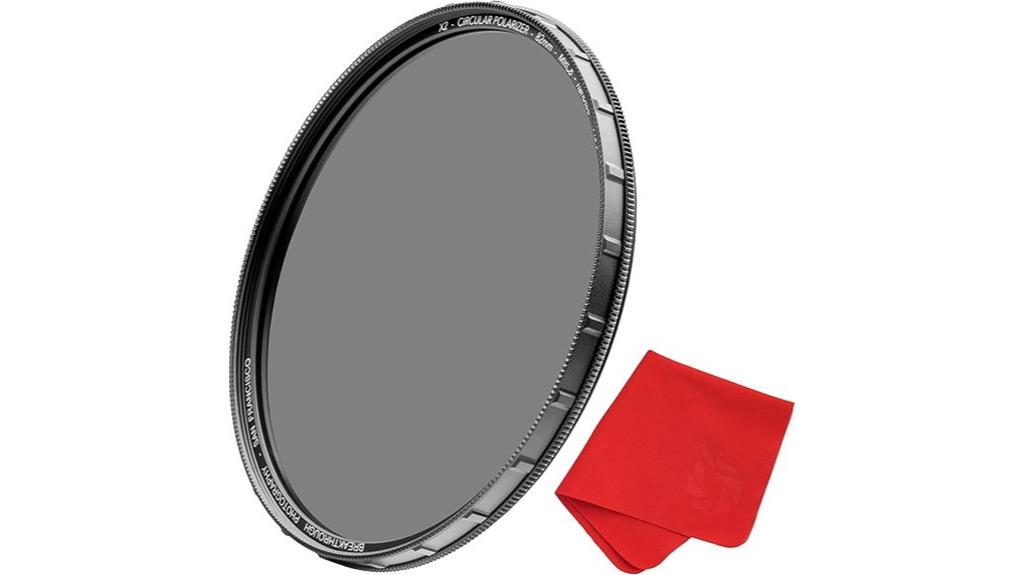
The 67mm X2 CPL Circular Polarizing Filter by Breakthrough Photography is an excellent choice for outdoor photographers seeking superior image quality and durability. Made with critically sharp AGC optical glass from Japan, it delivers excellent color neutrality and features an ultra-slim profile that minimizes vignetting. The MRC8 multilayer coating reduces glare, ghosting, and reflections, especially during long exposures, while the Nanotec hydrophobic coating repels dirt and water, making cleaning effortless. Its weather-sealed construction guarantees it withstands harsh environments. Compatible with all 67mm lenses, this filter enhances color saturation and deepens skies, providing clearer, more vibrant images in challenging outdoor conditions.
Best For: outdoor photographers and landscape enthusiasts seeking durable, high-quality circular polarizing filters to improve image clarity and protect their lenses in challenging conditions.
Pros:
- Crafted with critically sharp Japanese AGC optical glass for excellent color neutrality and clarity.
- Features an ultra-slim profile that minimizes vignetting and enhances portability.
- Equipped with MRC8 multilayer and Nanotec hydrophobic coatings for superior glare reduction and easy cleaning.
Cons:
- Compatibility limited to 67mm lens threads; incompatible with lenses of different sizes without adapters.
- Slightly higher price point compared to basic filters, reflecting premium quality.
- Requires proper threading and handling to avoid cross-threading or damage during installation.
SVBONY SV220 Telescope Filter, Dual-Band Nebula, H-Alpha and O-III Narrowband for Astrophotography

Designed for astrophotographers seeking to capture detailed nebulae amid light pollution, the SVBONY SV220 Telescope Filter offers dual-band H-Alpha and O-III narrowband filtration that enhances contrast and reduces interference from moonlight and artificial lighting. This 1.25-inch filter effectively blocks almost all moon-glow and street lighting, allowing for high-contrast imaging even during full moons or in urban environments. It’s compatible with various cameras, including OSC and DSLR models, and improves nebula visibility without overly brightening the images. Users report excellent results, comparable to more expensive filters, making it a great choice for deep-sky astrophotography.
Best For: amateur astrophotographers and urban stargazers seeking to enhance nebula imaging while reducing light pollution effects with an affordable, easy-to-use narrowband filter.
Pros:
- Effectively reduces light pollution and moon-glow, enabling high-contrast nebula imaging in urban environments
- Compatible with a variety of cameras including DSLR and OSC models, simplifying astrophotography workflows
- Provides excellent contrast enhancement comparable to higher-priced filters, with minimal haloing at typical exposure times
Cons:
- Requires increased exposure times or higher ISO settings, which may demand longer imaging sessions
- Not suitable for reflection nebulae or galaxy imaging due to its narrowband pass restrictions
- Some users may experience limited compatibility with certain telescope models or weather conditions
Celestron Narrowband Oxygen III 1.25 Filter

For serious amateur astronomers seeking to improve nebula observations in light-polluted areas, the Celestron Narrowband Oxygen III 1.25 Filter offers exceptional contrast enhancement. It isolates doubly-ionized oxygen emission lines at 496nm and 501nm, making nebulae like the Veil, Ring, or Orion more detailed and vivid. Built with high-quality, durable glass and an ultra-hard coating, it effectively blocks unwanted wavelengths from 400 to 700 nm. The filter threads onto standard eyepieces easily and resists scratches and drops. Overall, it’s a reliable, cost-effective choice for enhancing nebula visibility in challenging observing conditions, providing clear, detailed views even from suburban skies.
Best For: Serious amateur astronomers seeking to enhance nebula observations and reduce light pollution in suburban or urban environments.
Pros:
- Provides high contrast by isolating oxygen emission lines at 496nm and 501nm, revealing nebulae details more vividly.
- Constructed with durable, high-quality glass and an ultra-hard coating, resisting scratches and drops.
- Effective at suppressing light pollution from artificial sources, improving visibility from light-polluted areas.
Cons:
- Price has increased to near $100, making it less budget-friendly compared to initial lower-cost options.
- May produce a blue tint and halos around bright stars, which can be unappealing to some users.
- Performance can vary slightly depending on supplier quality control, possibly affecting consistency.
Celestron 94303 Eyepiece & Filter Kit (14 Pieces)
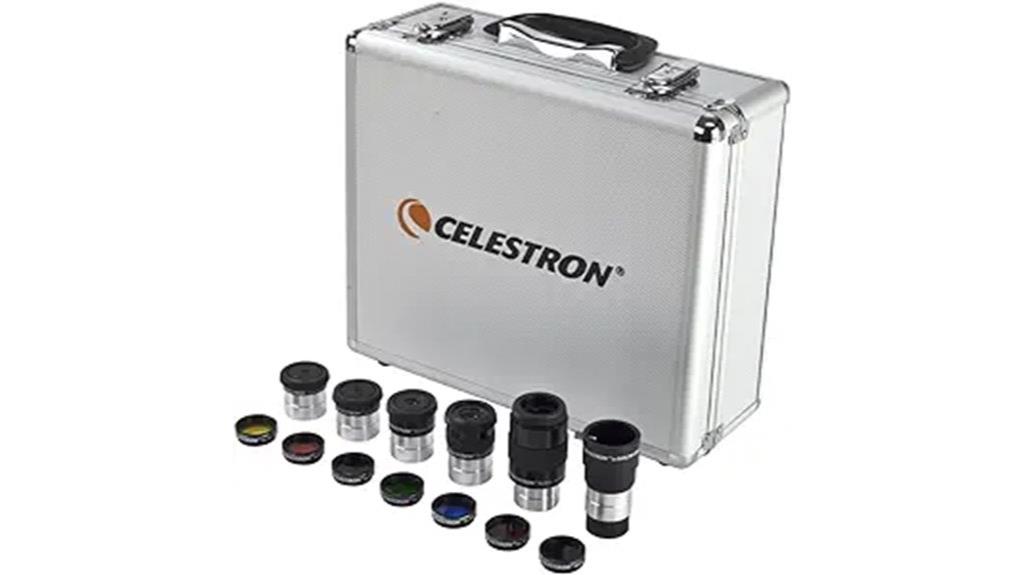
If you’re serious about enhancing your stargazing experience, the Celestron 94303 Eyepiece & Filter Kit (14 Pieces) offers a complete set of tools to elevate your observations. It includes five high-quality Plossl eyepieces with varying magnifications, plus a 2x Barlow lens to double their power. The kit also features six colored filters to improve contrast and highlight specific celestial details. Everything fits securely in a padded aluminum case for easy transport and storage. This versatile kit provides sharp, clear images and targeted filtering, making it ideal for amateur astronomers who want a comprehensive and portable observing solution.
Best For: amateur astronomers and stargazing enthusiasts seeking a comprehensive, portable kit for detailed celestial observation and imaging.
Pros:
- Includes a versatile set of five high-quality Plossl eyepieces with multiple magnification options and a 2x Barlow lens for expanded viewing possibilities
- Comes with six colored filters that enhance contrast and highlight specific celestial details for improved observation
- Features a padded aluminum carrying case, ensuring secure storage and easy portability of all components
Cons:
- The kit may be too comprehensive for casual stargazers who only need basic eyepieces and filters
- Some users might find the wide range of accessories overwhelming or unnecessary for their specific needs
- The high-quality components and portability come at a higher price point compared to simpler eyepiece sets
Celestron 1.25 inch Moon Filter

The Celestron 1.25 inch Moon Filter stands out as an essential tool for astronomers seeking sharper lunar views and better contrast. It effectively reduces glare and enhances surface details, making craters and maria more visible. This filter also works well for observing bright planets and terrestrial scenes over snow or sand. Easy to install, it threads onto most 1.25-inch eyepieces in seconds, ensuring quick setup. Whether you’re exploring the Moon’s surface or viewing bright planets, this filter improves contrast and clarity. It’s a simple yet invaluable addition to any amateur astronomer’s toolkit, elevating your lunar and planetary observations.
Best For: amateur astronomers and stargazing enthusiasts seeking enhanced lunar and planetary details with easier observation setup.
Pros:
- Reduces glare and increases contrast for clearer lunar surface details
- Easily threads onto most 1.25-inch eyepieces for quick installation
- Versatile for observing bright planets and terrestrial scenes over snow or sand
Cons:
- Limited to 1.25-inch eyepieces, not compatible with larger telescope accessories
- May slightly dim the view, requiring adjustments in brightness settings
- Primarily designed for bright objects; less effective during low-light conditions
K&F Concept 77mm ND8 and CPL Lens Filter for Camera

Looking to enhance your outdoor photography with versatile filter options? The K&F Concept 77mm ND8 CPL Lens Filter combines neutral density and circular polarizer functions in one device. It reduces light for longer exposures and boosts color saturation, contrast, and glare reduction, especially in bright conditions. Made from high-quality Japanese AGC optical glass with multi-layer coatings, it’s durable and easy to clean. Its ultra-slim 5.3mm frame minimizes vignetting, while the CNC non-slip design guarantees a secure fit. Compatible with all 77mm lenses, this filter is perfect for capturing stunning landscapes and outdoor scenes with improved clarity and color.
Best For: outdoor photographers and landscape enthusiasts seeking versatile filters to enhance image quality in bright or challenging lighting conditions.
Pros:
- Combines ND8 and CPL functions in a single, convenient filter for versatile use
- Made from high-quality Japanese AGC optical glass with multi-layer coatings for durability and easy maintenance
- Ultra-slim 5.3mm frame minimizes vignetting, ideal for wide-angle shots
Cons:
- Compatibility requires verification of lens thread size (marked with ø) before purchase
- Multi-layer coatings may require careful cleaning to avoid damage
- Designed specifically for 77mm lenses, limiting use with other sizes without adapters
Celestron RASA 8 Imaging Filter for Nebulae

For amateur astronomers passionate about capturing detailed images of emission nebulae, the Celestron RASA 8 Imaging Filter for Nebulae offers targeted wavelength transmission that markedly enhances contrast. Designed specifically for the RASA 8” f/2 astrograph, it transmits key wavelengths: Hydrogen-Alpha, Hydrogen-Beta, and Oxygen III, boosting nebulae details while blocking light pollution. Made from Schott glass with anti-reflection coatings, it ensures high transmission—over 85% at key wavelengths—with minimal light leak. While some users report halos or reflections, the filter considerably improves contrast and detail in emission nebulae images, making it a valuable tool for dedicated astrophotographers.
Best For: amateur astronomers and astrophotographers focused on capturing detailed images of emission nebulae using narrowband imaging with their RASA 8” setup.
Pros:
- Transmits key wavelengths (Hydrogen-Alpha, Hydrogen-Beta, Oxygen III) for enhanced emission nebulae contrast.
- Constructed with high-quality Schott glass and anti-reflection coatings to maximize light transmission.
- Fits seamlessly into the RASA 8” filter mount, making installation straightforward.
Cons:
- Reports of halos around bright stars and reflections from the corrector or cables when used with RASA 8”.
- Mixed user reviews, with some finding it less effective than alternative filters like the IDAS NBZ.
- Not suitable for broadband objects such as galaxies or star clusters, limiting its versatility.
Celestron EclipSmart Solar Eclipse Telescope Filter

If you’re planning to observe solar events safely, the Celestron EclipSmart Solar Eclipse Telescope Filter stands out as an excellent choice, especially for amateur astronomers and eclipse enthusiasts. It transforms compatible telescopes into dedicated solar scopes, allowing detailed views of the Sun, sunspots, and eclipses. Designed for models like PowerSeeker 127EQ and NexStar 130SLT, it’s easy to attach with snug hook and loop straps and includes a safety cap for storage. Conforming to ISO safety standards, it blocks harmful IR, UV, and 99.999% of visible light thanks to Solar Safe technology. Its natural orange tint offers clear, safe solar observation and imaging.
Best For: amateur astronomers, eclipse enthusiasts, and anyone seeking a safe, easy way to observe and photograph the Sun with compatible telescopes.
Pros:
- Conforms to international safety standards (ISO 12312-2:2015) for direct solar viewing.
- Blocks harmful IR, UV, and 99.999% of visible light, ensuring safe observation.
- Easy to attach with snug hook and loop straps and includes a protective safety cap.
Cons:
- Compatible only with specific telescope models listed by the manufacturer.
- Orange tint may slightly alter the natural appearance of the Sun compared to other filters.
- Not suitable for use with non-compatible telescopes or binoculars without appropriate adapters.
Celestron EclipSmart Solar Eclipse Telescope and Camera Filter

The Celestron EclipSmart Solar Eclipse Telescope and Camera Filter stands out as an excellent choice for amateur astronomers and solar enthusiasts seeking a safe, versatile way to observe and photograph the Sun. It transforms telescopes, spotting scopes, and DSLR cameras into solar scopes, compatible with objective lenses or barrels from 75mm to 100mm. Made with quality materials and conforming to international safety standards, it provides protection against IR, UV, and most visible light. Easy to assemble and lightweight, it’s perfect for solar viewing during eclipses and daily sunspot observation. While not suitable for large telescopes or viewing prominences, it’s a reliable, portable tool for safe solar imaging.
Best For: amateur astronomers, solar enthusiasts, and photographers seeking a safe, portable way to observe and capture solar events with compatible telescopes and cameras.
Pros:
- Conforms to international safety standards with effective IR, UV, and visible light protection
- Versatile and compatible with a range of telescopes, spotting scopes, and DSLR cameras from 75mm to 100mm
- Lightweight, foldable design makes it easy to transport and store, ideal for eclipse viewing and daily sunspot observation
Cons:
- Constructed mainly from fragile cardboard and coated paper, which may be prone to damage
- Difficult to secure properly on larger lenses or telescopes due to size constraints and fit issues
- Not suitable for large aperture reflector or Cassegrain telescopes, limiting its use with bigger systems
Celestron EclipSmart Solar Eclipse Telescope Filter

Designed specifically for safe solar viewing, the Celestron EclipSmart Solar Eclipse Telescope Filter offers an easy-to-use, secure fit with select Celestron models, making it ideal for enthusiasts wanting reliable protection during eclipses and sunspot observations. It complies with ISO 12312-2:2015(E) safety standards, ensuring safe direct sun viewing. The filter features three safety screws for a secure attachment and a protective cap for storage. Made in the USA by American Paper Optics, it’s independently tested for quality. Its orange tint provides natural-looking views, enhancing both visual observation and astrophotography, backed by Celestron’s trusted brand and US-based support.
Best For: enthusiasts and amateur astronomers seeking a safe, reliable way to observe solar eclipses, sunspots, and the Sun with compatible telescopes.
Pros:
- Conforms to ISO 12312-2:2015(E) safety standards for secure solar viewing
- Made in the USA with independently tested, high-quality materials by American Paper Optics
- Features a natural orange tint that enhances visual and photographic solar observations
Cons:
- Compatible only with specific Celestron AstroMaster models, limiting universal applicability
- Comes with safety screws and a protective cap, but installation may require careful handling for secure attachment
- May slightly alter the natural color of the Sun due to the orange tint, which might not suit all viewers’ preferences
Celestron EclipSmart Solar Eclipse Telescope Filter

For amateur astronomers enthusiastic to safely observe solar eclipses, the Celestron EclipSmart Solar Eclipse Telescope Filter stands out as a reliable choice. Designed specifically for Celestron 6” Schmidt-Cassegrain telescopes, it conforms to ISO safety standards, ensuring protection from harmful IR, UV, and visible light. The lightweight filter features American-made Solar Safe film, providing a natural orange Sun view, perfect for imaging or visual observation. Easy to install with secure attachment methods, it offers safe, clear solar views during events like the 2023 Annular and 2024 Total Solar Eclipse. Customers praise its quality, affordability, and confidence-inspiring safety features.
Best For: amateur astronomers and eclipse enthusiasts seeking a safe, affordable, and easy-to-use solar viewing filter for their Celestron 6” Schmidt-Cassegrain telescopes.
Pros:
- Conforms to ISO 12312-2:2015(E) safety standards, ensuring safe direct solar observation
- Made from American Solar Safe film, providing natural Sun imagery and high-quality imaging results
- Lightweight, easy to install, and equipped with secure attachment methods for reliable use
Cons:
- Fragile film material requiring careful handling and storage to prevent tears
- May not fit some older or specific telescope models, such as C-5 from 2007 or earlier
- Limited durability; not suitable for prolonged use or rough handling
Svbony SV227 2 Narrow-Band Filter Kit
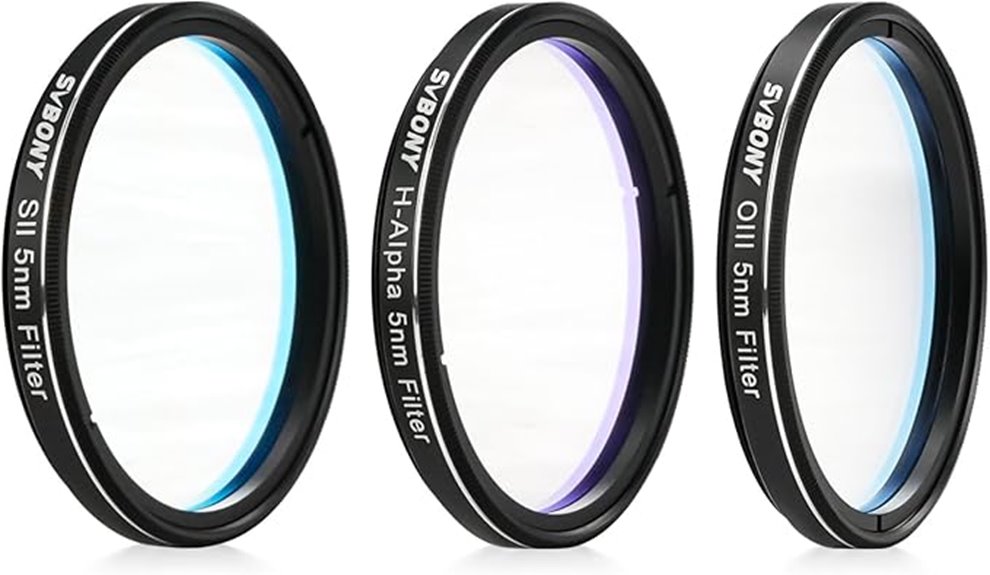
If you’re passionate about capturing detailed images of nebulae, the Svbony SV227 2 Narrow-Band Filter Kit offers a reliable solution. This kit includes three 5nm filters—SII, H-Alpha, and OIII—that isolate specific emission lines, boosting contrast and detail. Designed for monochrome astrophotography, the filters thread directly into 2-inch telescope barrels, making setup straightforward. They reduce light pollution and maintain high transmittance by minimizing CWL shift. Each filter is tested for quality, ensuring consistent performance. Whether you’re observing nebulae or capturing astrophotography, this kit provides enhanced clarity and feature visibility, making it a valuable addition to your gear.
Best For: amateur and professional astrophotographers seeking to enhance nebula imaging with high-quality narrow-band filters.
Pros:
- Includes three specialized 5nm filters (SII, H-Alpha, OIII) for detailed emission line imaging.
- Compatible with 2-inch telescope barrels for easy installation and versatile use.
- Effectively reduces light pollution while maintaining high transmittance through minimized CWL shift.
Cons:
- Customer rating is 3.8 out of 5 stars, indicating mixed reviews on performance or value.
- Relatively lightweight and compact, which may raise concerns about durability for some users.
- Limited to monochrome astrophotography, requiring color cameras or stacking techniques for full-color images.
Celestron AstroMaster 8-Piece Eyepiece & Filter Accessory Kit
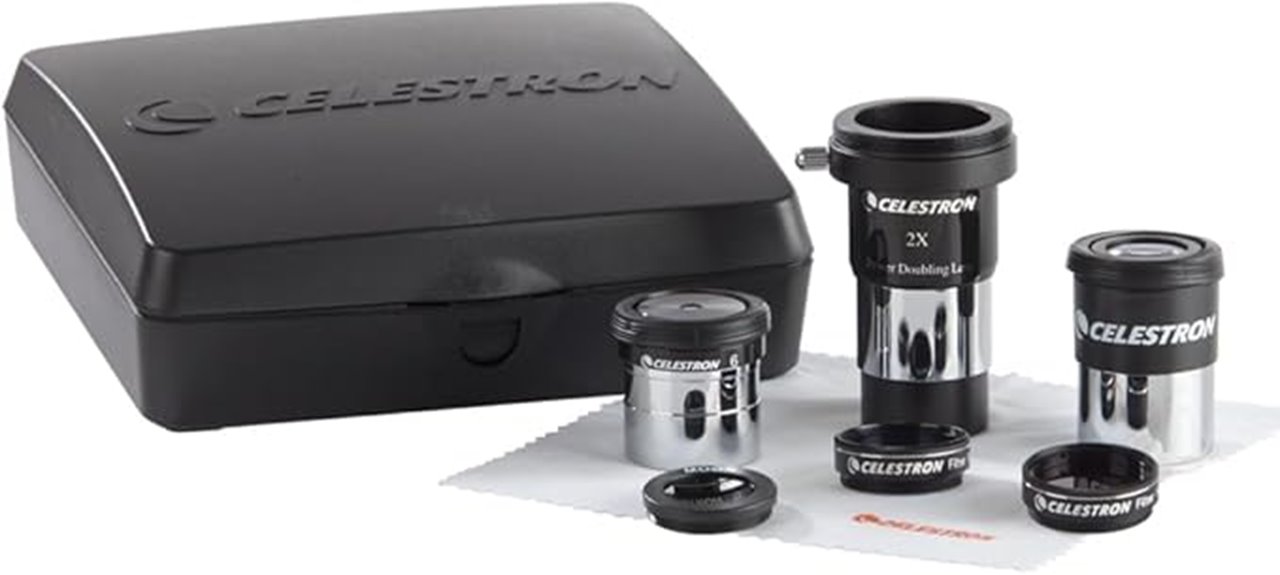
The Celestron AstroMaster 8-Piece Eyepiece & Filter Accessory Kit stands out as an excellent choice for amateur astronomers seeking versatile tools to enhance their stargazing experience. It includes two eyepieces—15mm Kellner and 6mm Plossl—along with a 2x Barlow lens, providing flexible magnification options for detailed planetary and lunar views. The kit features high-quality coated lenses that ensure brighter, sharper images while minimizing glare. With filters like #80A Blue, #25 Red, and Moon, you can boost contrast and reduce glare for improved lunar and planetary observations. The sturdy case keeps everything organized and protected during transport and storage.
Best For: amateur astronomers and stargazing enthusiasts seeking versatile, high-quality eyepieces and filters to enhance celestial observation experiences.
Pros:
- Includes a variety of eyepieces and filters for versatile viewing options and improved contrast.
- High-quality coated lenses deliver brighter, sharper images with minimal glare.
- Durable plastic case with custom foam provides organized, protected storage for transport and long-term use.
Cons:
- May be less suitable for advanced astronomers requiring higher magnification options.
- The 2x Barlow lens can sometimes introduce slight image distortion or reduce image brightness.
- Limited to 8 pieces, which might not cover all observational needs for more advanced users.
Factors to Consider When Choosing a Celestron Duo Band Filter

When selecting a Celestron Duo Band Filter, I consider compatibility with my telescope and eyepieces to guarantee a perfect fit. I also pay attention to the wavelength transmission range, optical quality, and coatings for clear images, along with how well it reduces light pollution. Finally, I look for filters that are easy to install and use, so my stargazing sessions stay smooth and enjoyable.
Compatibility With Equipment
Choosing the right Celestron Duo Band filter requires careful attention to compatibility with your equipment. First, check that the filter’s thread size matches your telescope or camera to guarantee a secure fit. Compatibility with your specific imaging or observing setup is vital—whether you’re using DSLR, monochrome, or OSC cameras, or particular telescope models. Additionally, verify that the filter’s bandwidth and wavelength transmission align with your target objects, like nebulae or emission lines. Consider the materials and coatings to make certain they suit your equipment’s optical specifications and environmental conditions. Finally, review manufacturer specifications for any notes or limitations, especially for specialized filters like dual-band or narrowband options. Confirming compatibility helps you get the best performance and clarity during your stargazing sessions.
Wavelength Transmission Range
Selecting a Celestron Duo Band filter involves paying close attention to its wavelength transmission range, which determines the specific spectral lines it can pass. This range is pivotal because it influences which emissions from nebulae or other celestial objects are visible. A wider transmission range allows more light to pass through, but it can reduce contrast, making features less distinct. Conversely, a narrower range isolates specific emissions, enhancing detail and contrast. These ranges are typically specified in nanometers, such as 486nm for Hydrogen-Beta or 496/501nm for Oxygen III lines. The effectiveness of the filter hinges on how well its transmission overlaps with the emission lines of your target objects. Consistent, well-defined ranges ensure reliable imaging results under different observing conditions.
Optical Quality and Coatings
Optical quality and coatings play a crucial role in maximizing the performance of Celestron Duo Band filters. High-quality coatings, such as dielectric or anti-reflective layers, enhance light transmission at key wavelengths, improving contrast and clarity. These multi-layer coatings also reduce reflections, glare, ghosting, halos, and color fringing, resulting in sharper, more detailed views of celestial objects. Durability is equally important; robust coatings resist scratches, environmental damage, and degradation over time, maintaining ideal performance. For dual-band filters, tailored coatings optimize the transmission of emission lines like H-alpha and OIII, boosting contrast and revealing more intricate nebula details. Investing in filters with superior coatings ensures you get clearer, more accurate images, making your stargazing sessions in 2025 truly exceptional.
Light Pollution Reduction
Light pollution can considerably diminish the quality of your stargazing sessions, especially in urban or suburban areas. That’s where light pollution reduction filters come in—they block common artificial light wavelengths, like streetlights and city glow, improving contrast and revealing more celestial details. Narrowband filters target specific emission lines such as Hydrogen-Alpha, Oxygen III, or Hydrogen-Beta, which are less affected by light pollution, making nebulae stand out vividly. These filters help suppress broadband light sources, allowing faint deep-sky objects to be seen clearly. Properly chosen light pollution filters can double or triple the contrast of faint objects, dramatically enhancing your viewing experience. If you’re in a light-polluted area, investing in a good light pollution reduction filter is a game-changer for observing the night sky.
Ease of Installation
When choosing a Celestron Duo Band filter, ease of installation should be a top priority to guarantee a hassle-free setup. Make sure the filter has compatible threading or mounting options that match your telescope or camera equipment, so attaching it is straightforward. Look for models with clear instructions or user-friendly features like quick-clip or snap-in mechanisms—these make setup faster and less frustrating. A sturdy, well-constructed frame is also key, as it allows for easy handling and secure attachment without needing extra tools or adapters. Additionally, choose filters made from materials and coatings that are simple to clean and remove, saving time and effort during adjustments. Lightweight and compact designs are helpful too, especially when working in tight or awkward spaces.
Durability and Build
To guarantee your Celestron Duo Band filter stands up to regular use, durability and build quality are essential factors to consider. I look for filters with high-quality optical coatings that are scratch-resistant and can handle frequent handling without damage. A sturdy frame, whether metal or high-grade plastic, helps hold the optical elements securely and resists impacts or drops. Weather-sealed construction is a bonus, as it shields the filter from moisture, dust, and environmental stress, extending its lifespan outdoors. The glass or substrate should be hardened, resistant to shattering or clouding over time. Proper threading and a snug fit are also vital, preventing loosening during use and ensuring consistent performance. Overall, a well-built filter lasts longer and maintains optical quality.
Specific Observation Targets
Choosing the right duo band filter depends heavily on your observation targets, as different filters are designed to highlight specific emission lines. For observing emission nebulae like the Orion or Lagoon, I recommend filters that focus on H-Alpha and O-III wavelengths, which bring out their vibrant details. If you’re interested in planetary nebulae, selecting filters that enhance O-III or H-Beta lines will improve contrast and reveal their structures more clearly. For deep-sky objects emitting multiple spectral lines, a duo band filter tailored to those emissions provides a more detailed view. The specific combination of emission lines in a filter directly affects its effectiveness in revealing particular phenomena, so matching your target with the appropriate filter is essential for ideal results.
Frequently Asked Questions
How Do Celestron Duo Band Filters Improve Deep-Sky Object Observation?
Celestron Duo Band Filters improve deep-sky object observation by blocking out unwanted light pollution and moonlight, enhancing contrast and detail. I notice sharper, more vibrant views of nebulae and galaxies because these filters isolate specific wavelengths, reducing glare. They make faint objects stand out more clearly, giving me a richer stargazing experience. Overall, these filters help me see the universe more vividly and with greater clarity.
Can These Filters Be Used With Smartphones or Only Telescopes?
You can’t use Celestron Duo Band Filters directly with smartphones. They’re designed to attach to telescopes’ eyepieces, enhancing your viewing experience. If you’re interested in astrophotography or capturing images, you’ll need a dedicated camera or smartphone adapter compatible with your telescope. I recommend checking the filter’s specifications and your equipment to guarantee proper fit and maximum performance for your stargazing adventures.
Are Celestron Duo Band Filters Compatible With All Telescope Brands?
Yes, Celestron Duo Band Filters are compatible with most telescope brands. I’ve used them with various models, and they fit securely without any issues. But, it’s always smart to double-check the thread size or mounting style of your telescope before purchasing. This way, you can guarantee a perfect fit and enjoy clearer, more vibrant views of the night sky, no matter what telescope you own.
What Maintenance Is Required to Keep Filters in Optimal Condition?
To keep my filters in top shape, I regularly clean them with a soft, lint-free cloth and a gentle lens cleaner to remove dust and smudges. I always store them in a protective case when not in use to prevent scratches. I also avoid touching the glass directly and handle them carefully during setup and maintenance, ensuring they stay clear and effective for peak stargazing.
How Do I Choose the Best Duo Band Filter for My Astrophotography Needs?
When choosing the best duo band filter for my astrophotography, I focus on my target objects and camera compatibility. I consider the specific wavelengths the filter enhances, like hydrogen-alpha or oxygen-III, to improve contrast and detail. I also check reviews and specifications to confirm it matches my telescope and camera setup. Ultimately, I pick a filter that balances quality and price to meet my imaging goals effectively.
Conclusion
Choosing the right Celestron duo band filter is like finding the perfect lens to reveal the universe’s hidden masterpiece. With so many options, you’ll want one that sharpens your view and brings clarity to the stars. Remember, the right filter acts like a key revealing celestial secrets, making your stargazing experience more vivid and awe-inspiring. So, pick wisely, and get ready to explore the cosmos with newfound clarity and wonder.
